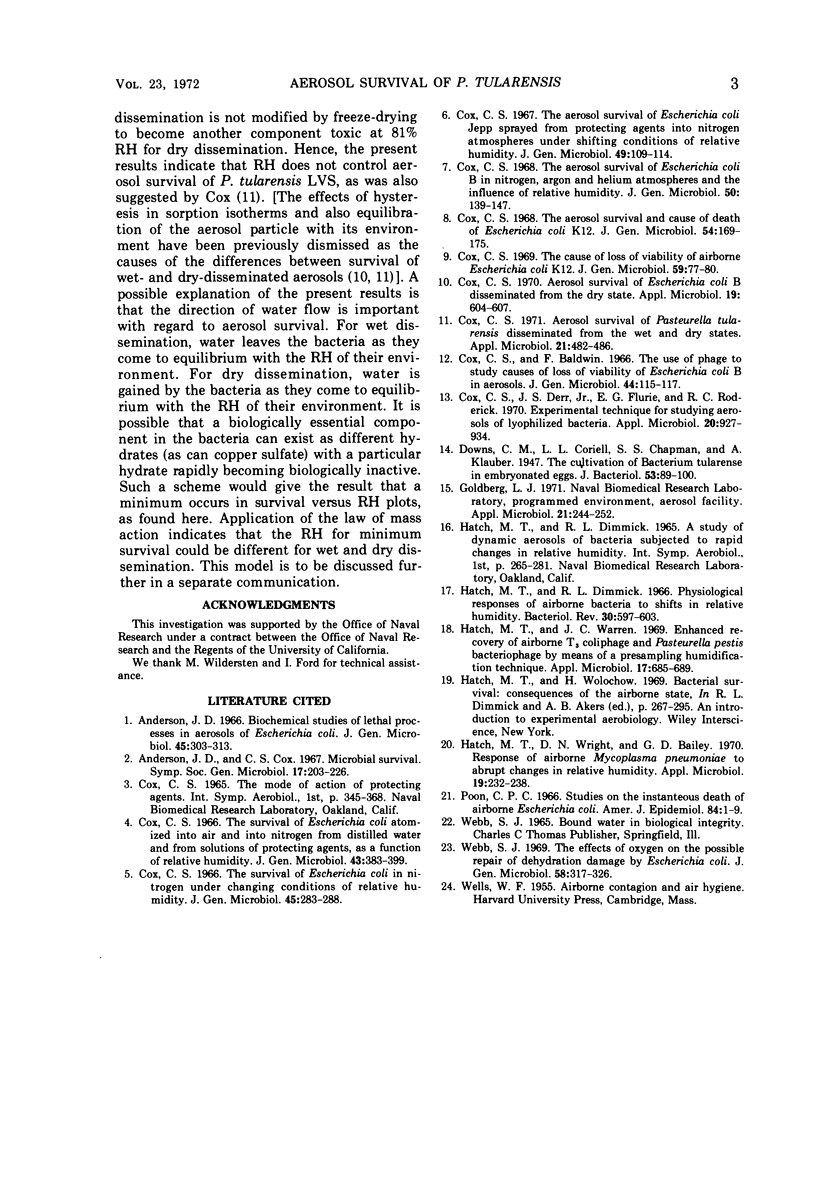Abstract
The aerosol survival in air was determined for Pasteurella tularensis live vaccine strain (LVS) as a function of relative humidity (RH). Three different preparations of bacteria were used: (i) liquid suspension of P. tularensis LVS in spent culture medium; (ii) powders of P. tularensis LVS freeze-dried in spent culture fluid; (iii) P. tularensis LVS freeze-dried in spent culture fluid and then reconstituted with distilled water and disseminated as a liquid suspension. Preparation (i) gave greatest survival at high RH and lowest survival at intermediate RH. Preparation (ii), in contrast, gave greatest survival at low RH and minimum survival at 81% RH. Preparation (iii) was the same as preparation (i), i.e., the process of freeze-drying and reconstituting with distilled water before aerosol formation had little or no effect upon aerosol survival as a function of RH. Hence, control of aerosol survival appears to be through the water content of P. tularensis LVS at the moment of aerosol generation rather than the water content of the bacteria in the aerosol phase.
Full text
PDF


Selected References
These references are in PubMed. This may not be the complete list of references from this article.
- Anderson J. D. Biochemical studies of lethal processes in aerosols of Escherichia coli. J Gen Microbiol. 1966 Nov;45(2):303–313. doi: 10.1099/00221287-45-2-303. [DOI] [PubMed] [Google Scholar]
- Cox C. S. Aerosol survival of Escherichia coli B disseminated from the dry state. Appl Microbiol. 1970 Apr;19(4):604–607. doi: 10.1128/am.19.4.604-607.1970. [DOI] [PMC free article] [PubMed] [Google Scholar]
- Cox C. S. Aerosol survival of Pasteurella tularensis disseminated from the wet and dry states. Appl Microbiol. 1971 Mar;21(3):482–486. doi: 10.1128/am.21.3.482-486.1971. [DOI] [PMC free article] [PubMed] [Google Scholar]
- Cox C. S., Derr J. S., Jr, Flurie E. G., Roderick R. C. Experimental technique for studying aerosols of lyophilized bacteria. Appl Microbiol. 1970 Dec;20(6):927–934. doi: 10.1128/am.20.6.927-934.1970. [DOI] [PMC free article] [PubMed] [Google Scholar]
- Cox C. S. The aerosol survival and cause of death of Escherichia coli K12. J Gen Microbiol. 1968 Dec;54(2):169–175. doi: 10.1099/00221287-54-2-169. [DOI] [PubMed] [Google Scholar]
- Cox C. S. The aerosol survival of Escherichia coli B in nitrogen, argon and helium atmospheres and the influence of relative humidity. J Gen Microbiol. 1968 Jan;50(1):139–147. doi: 10.1099/00221287-50-1-139. [DOI] [PubMed] [Google Scholar]
- Cox C. S. The aerosol survival of Escherichia coli JEPP sprayed from protecting agents into nitrogen atmospheres under changing relative humidity conditions. J Gen Microbiol. 1967 Oct;49(1):109–114. doi: 10.1099/00221287-49-1-109. [DOI] [PubMed] [Google Scholar]
- Cox C. S. The cause of loss of viability of airborne Escherichia coli K12. J Gen Microbiol. 1969 Jul;57(1):77–80. doi: 10.1099/00221287-57-1-77. [DOI] [PubMed] [Google Scholar]
- Cox C. S. The survival of Escherichia coli in nitrogen atmospheres under changing conditions of relative humidity. J Gen Microbiol. 1966 Nov;45(2):283–288. doi: 10.1099/00221287-45-2-283. [DOI] [PubMed] [Google Scholar]
- Cox C. S. The survival of Escherichia coli sprayed into air and into nitrogen from distilled water and from solutions of protecting agents, as a function of relative humidity. J Gen Microbiol. 1966 Jun;43(3):383–399. doi: 10.1099/00221287-43-3-383. [DOI] [PubMed] [Google Scholar]
- Downs C. M., Coriell L. L., Chapman S. S., Klauber A. The Cultivation of Bacterium tularense in Embryonated Eggs. J Bacteriol. 1947 Jan;53(1):89–100. [PMC free article] [PubMed] [Google Scholar]
- Goldberg L. J. Naval biomedical research laboratory, programmed environment, aerosol facility. Appl Microbiol. 1971 Feb;21(2):244–252. doi: 10.1128/am.21.2.244-252.1971. [DOI] [PMC free article] [PubMed] [Google Scholar]
- Hatch M. T., Dimmick R. L. Physiological responses of airborne bacteria to shifts in relative humidity. Bacteriol Rev. 1966 Sep;30(3):597–603. doi: 10.1128/br.30.3.597-603.1966. [DOI] [PMC free article] [PubMed] [Google Scholar]
- Hatch M. T., Warren J. C. Enhanced recovery of airborne T3 coliphage and Pasteurella pestis bacteriophage by means of a presampling humidification technique. Appl Microbiol. 1969 May;17(5):685–689. doi: 10.1128/am.17.5.685-689.1969. [DOI] [PMC free article] [PubMed] [Google Scholar]
- Hatch M. T., Wright D. N., Bailey G. D. Response of airborne Mycoplasma pneumoniae to abrupt changes in relative humidity. Appl Microbiol. 1970 Feb;19(2):232–238. doi: 10.1128/am.19.2.232-238.1970. [DOI] [PMC free article] [PubMed] [Google Scholar]
- Hendrix J. W., Lauder D. K. Effects of polyene antibiotics on growth and sterol-induction of oospore formation by Pythium periplocum. J Gen Microbiol. 1966 Jul;44(1):115–120. doi: 10.1099/00221287-44-1-115. [DOI] [PubMed] [Google Scholar]
- Poon C. P. Studies on the instantaneous death of airborne Escherichia coli. Am J Epidemiol. 1966 Jul;84(1):1–9. doi: 10.1093/oxfordjournals.aje.a120613. [DOI] [PubMed] [Google Scholar]
- Webb S. J. The effects of oxygen on the possible repair of dehydration damage by Escherichia coli. J Gen Microbiol. 1969 Nov;58(3):317–326. doi: 10.1099/00221287-58-3-317. [DOI] [PubMed] [Google Scholar]


